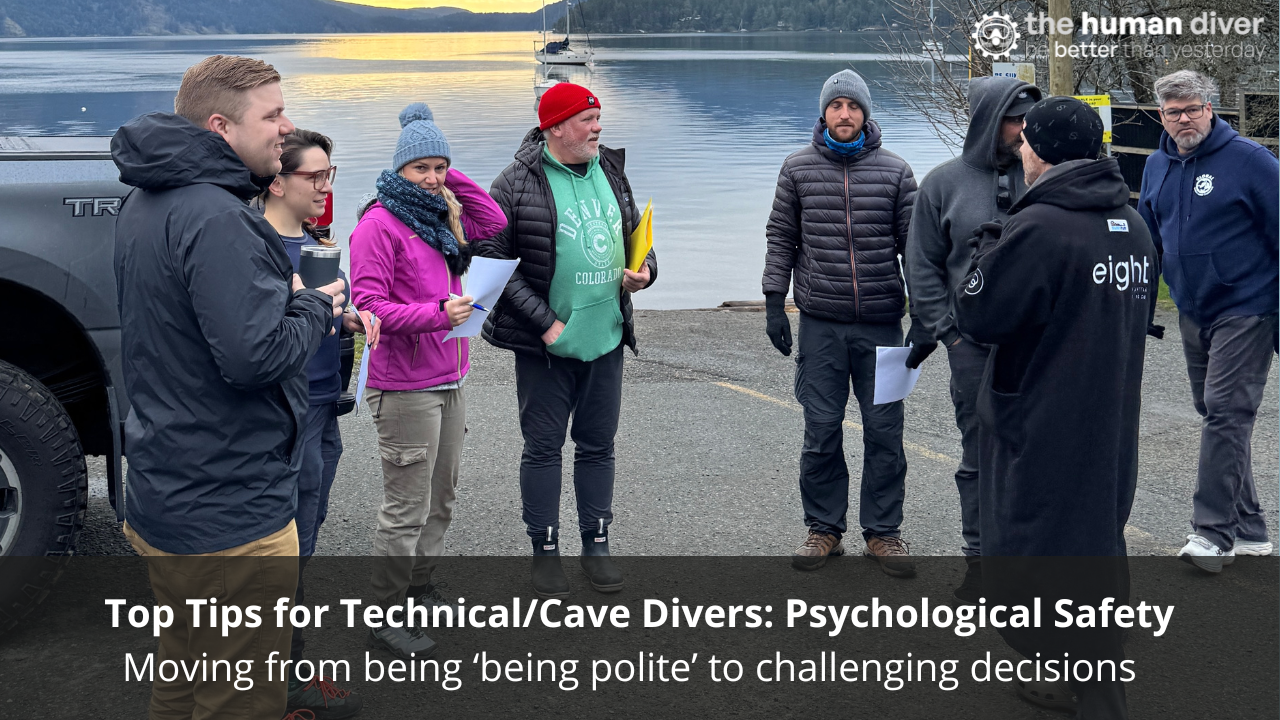
Why is it so hard to create a team quickly in diving? #2 - Learner Safety
Jan 12, 2021How do you make others feel safe and motivated to learn?
This is the second part in a series of four blogs which looks at building psychological safety within your instructional setting or ‘fun’ diving environments. The first part was on INCLUSION SAFETY where I showed how to increase the chances that your team members will feel included by creating the right environment.
Part One: Inclusion Safety
Part Two: Learner Safety (this article)
Part Three: Contributor Safety
Research has shown that once team members feel inclusion they will start to look and see how safe it is to make mistakes and what happens when mistakes are made. Note that mistakes in this context don’t have to be traditional mistakes involving the execution of the skill but could be as simple as saying something out of turn and the team say something to put them down. In a training environment, learner safety is critical. Students are expected to make mistakes as they are learning something new. How instructors or peers respond matters.

Adopt a student mindset.
The concept of a student implies that we are learning. We are all on a journey of learning in diving. We can never know it all, especially as new techniques, tools and knowledge are developed. This is the mindset we want to personally develop ourselves so that we don’t get arrogant or complacent in our learning. Use the word student with your team, even when you are the instructor! Help your team understand that while we may become skilled and develop skills and knowledge, we are always learning and will never arrive at a place of permanent competency.
Share what you are learning.
One of the most powerful ways to encourage others to learn is to share what you are learning. Share the topic, the insights, and most importantly the joy and satisfaction you have gained in the learning process. Your optimism and enthusiasm for learning is contagious. If you are an instructor, at the end of each day, consider sharing what you personally learned that day. You can reinforce this by running a team reflection at the end of the day using the question “One thing you learned today and why it was important?” and you start the discussion. Make it specific, not general. If you are specific, then others can see you thought about it rather than a glib general statement. If you are ‘fun’ diving, considering running a DEBrIEF using this template

Share past mistakes.
It’s hard to learn from mistakes if a team has a culture that hides its mistakes. I get this is hard in the diving community for the reasons identified in the last article. Take the opportunity to mention some of your mistakes, laugh at them, and share what you learned from them. Don’t just focus on the outcomes though, look at the conditions which led to the event. We can’t change outcomes, but we can change or influence the conditions. As the leader, when you share your mistakes or issues, you will encourage others to be more comfortable sharing their mistakes and trying to learn from them. Talking about failure and showing vulnerability are crucial to encourage others to learn.
Celebrate failures.
A failure is evidence that one of the team is learning through trial and effort. As long as team members fail within defined limits, you should encourage this behaviour. Indeed, as an instructor, you should be creating safe-to-fail environments if you are creating thinking divers. We should recognise that failure is not the exception; it’s the way forward if we are going to be improving and pushing the limits. We often learn more from failure than success. When a team member fails and learns from it, celebrate it. Communicate the accomplishment to the entire team, potentially at the end of the day when you are covering the ‘what one thing did I learn today’. Failure is normal, so destigmatize it celebrating the failures, how they were detected and corrected.

Ask for feedback at the moment of need.
It’s normal to encounter questions, problems, or challenges in the course of normal workflow, be that on a training course or on a ‘fun’ dive. What do you do? Unless it’s an obvious solution, teach your team to formulate a learning response (not an answer) to the problem and then ask a colleague to give feedback (not an answer). This habit will create a team norm of collaborative learning which increases learner safety. This technique is essential to create thinking divers. As an instructor, you will not be there in the real world when your students graduate. As such, they need to understand how to solve problems using the information, context and tools they have.

Every day is a learning day. As long as we realise that we can do amazing things because we continually improve. However, to do that we need to have an open mind with a growth mindset, not one which is fixed. If you are developing and pushing your boundaries, then you will be failing at some point too. If you are the leader or instructor in an environment where you have the potential to make mistakes, create the environment where you can learn from the mistakes, and if you can share them wider than your team so that others don’t need to make the same mistake, even better.

Gareth Lock is the owner of The Human Diver, a niche company focused on educating and developing divers, instructors and related teams to be high-performing. If you'd like to deepen your diving experience, consider taking the online introduction course which will change your attitude towards diving because safety is your perception, visit the website.
Want to learn more about this article or have questions? Contact us.










